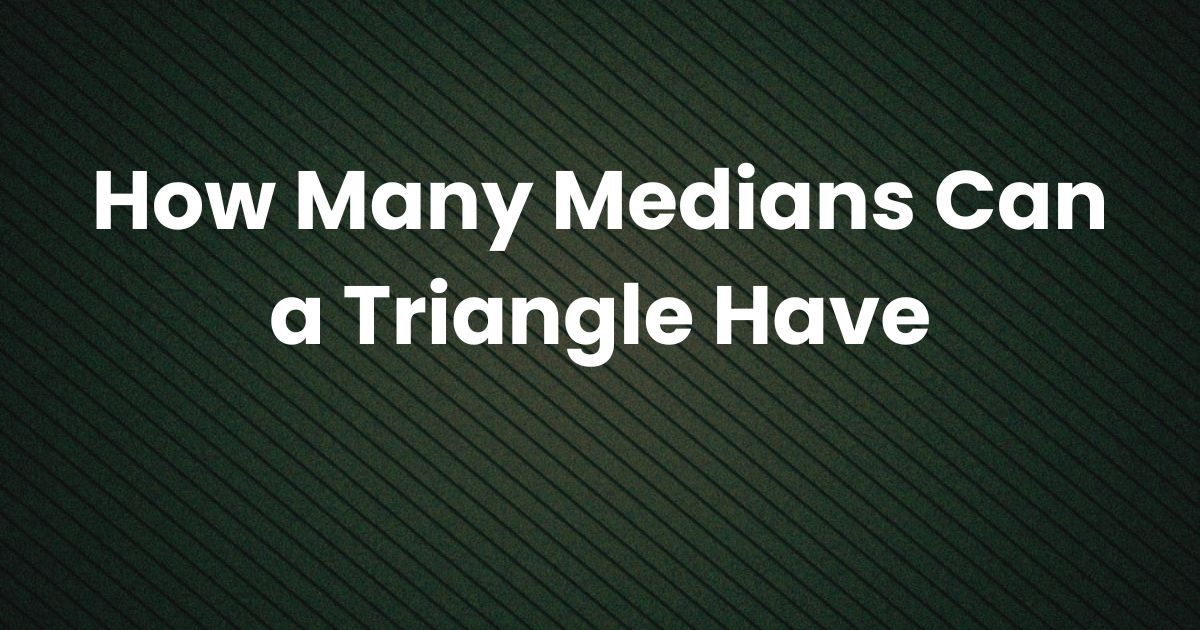
The straightforward solution is that every triangle has exactly three medians. A median of a triangle is a line segment that connects a vertex to the midpoint of the opposite side. In every triangle, no matter the shape or size, three such medians can always be drawn, and they all intersect at a single point known as the centroid.
Introduction
Triangles are one of the simplest and most fundamental shapes in geometry. Understanding their properties is essential in many areas of mathematics and science. Among the important features of a triangle are its medians. Medians not only help in understanding the triangle’s balance and symmetry but also play a crucial role in various geometric constructions and proofs.
What Is a Median?
A median is defined as a line segment that connects one vertex of the triangle to the midpoint of the opposite side. This means:
- Every triangle has three vertices.
- Each vertex has one median that extends from it.
- The midpoint of the opposite side is the point that divides that side into two equal segments.
For example, consider a triangle with vertices A, B, and C:
- The median from A goes to the midpoint of side BC.
- The median from B goes to the midpoint of side AC.
- The median from C goes to the midpoint of side AB.
How Many Medians Does a Triangle Have?
Since a triangle has three vertices and each vertex produces one median, every triangle has three medians. This is true for all triangles, whether they are scalene (no sides equal), isosceles (two sides equal), or equilateral (all sides equal).
Properties of Medians
Concurrency at the Centroid
One of the most interesting properties of the medians in a triangle is that they are always concurrent. This means that all three medians intersect at a single point called the centroid. The centroid is also known as the center of mass or the balance point of the triangle.
Division Ratio
The centroid has a unique property: it divides each median into two segments, where the segment connecting the centroid to the vertex is twice as long as the segment connecting the centroid to the midpoint of the side. This division ratio is always 2:1.
Balancing the Triangle
The centroid is the point where the triangle would balance perfectly if made from a uniform material. This property is not only fascinating from a theoretical standpoint but also has practical applications in fields such as physics and engineering.
Visualizing the Concept
Imagine you have a triangular piece of cardboard. If you find the midpoint of each side and draw a line from each vertex to the opposite midpoint, you’ll notice that these three lines converge at a single spot—the centroid. This is a simple yet powerful illustration of why every triangle has exactly three medians and how they interact.
Common Misconceptions
- More Than Three Medians:
Some may wonder if additional medians can be drawn. However, since a triangle only has three vertices, there is no vertex left to form another median. Hence, the maximum and only number of medians in a triangle is three. - Medians vs. Altitudes:
It’s important not to confuse medians with altitudes. While an altitude is a perpendicular segment from a vertex to the opposite side (or its extension), a median connects a vertex to the midpoint of the opposite side regardless of the angle at which it meets the side.
Applications in Geometry and Beyond
Understanding medians and the centroid has broad applications:
- Geometric Constructions:
The concept of medians is used in various geometric constructions and proofs. - Center of Mass:
In physics, the centroid is used to determine the center of mass of a triangular object, which is crucial in engineering and design. - Optimizing Locations:
The centroid can represent an optimal location in problems such as facility placement or resource distribution within triangular regions.
Conclusion
In conclusion, every triangle has exactly three medians. These medians, drawn from each vertex to the midpoint of the opposite side, not only define important geometric properties but also converge at a single point—the centroid—which divides each median in a 2:1 ratio. This fundamental characteristic of triangles is crucial in both theoretical and applied mathematics.
Disclaimer: This article is intended for educational and informational purposes only. The concepts discussed herein are based on standard principles of geometry. For further study or advanced applications, readers are encouraged to consult additional mathematical literature and educators.
Also Check:
• How Many Altitudes Can a Triangle Have? An Easy-to-Understand Guide
• How Many Lines Can Be Drawn Through Two Points? An In-Depth Exploration
• Can a Triangle Have Two Right Angles? Exploring the Limits of Triangle Geometry
• How Many Structural Isomers Can Be Drawn for Pentane? An Easy-to-Understand Guide



